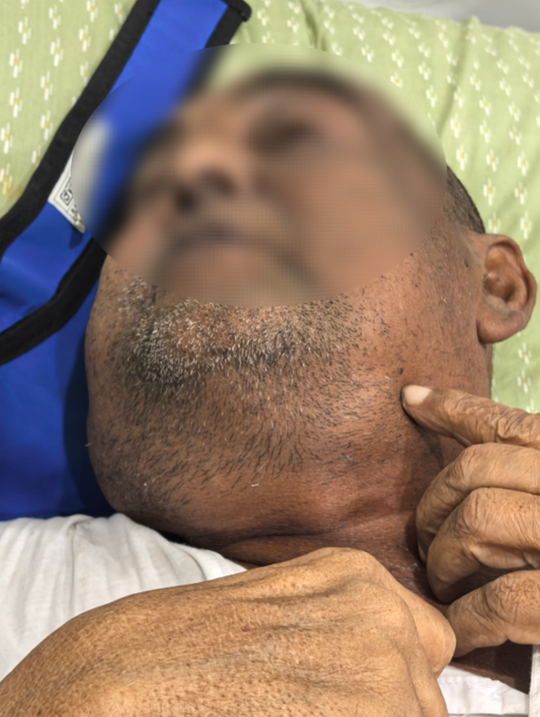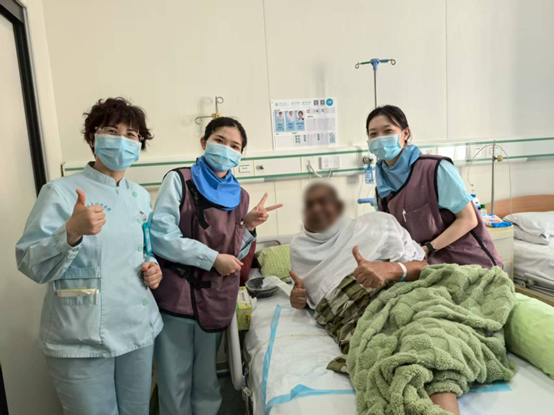Alifin (pseudonym), a farm owner from Malaysia, began suffering from unbearable headaches in May this year. When he went to the hospital for a checkup, the results were shocking — doctors discovered a 4.3 cm tumor in his brain. Further examination revealed that the real source of the problem was in his lungs: a malignant tumor (poorly differentiated adenocarcinoma) in the upper lobe of his left lung. The cancer had already spread to his brain, adrenal glands, and multiple lymph nodes in the neck and clavicle areas.
Alifin underwent brain tumor resection surgery at a local hospital, and postoperative pathology confirmed metastatic adenocarcinoma. However, the operation did not relieve his pain, and he had to rely on painkillers to get through each day. Just as his family was feeling desperate, a glimmer of hope appeared — Alifin’s sister got in touch with President Niu Lizhi of Guangzhou Fuda Cancer Hospital, who happened to be giving a lecture in Malaysia at the time.
When President Niu learned about his condition, Alifin was in very poor shape: his right face and neck were severely swollen, he suffered from constant neck pain, weakness in all limbs, and was unable to stand or take care of himself. After hearing that Guangzhou Fuda offered new treatment options different from traditional surgery, he decisively stopped all local treatments and flew to Guangzhou.

Upon his arrival, the scorching July heat of Guangzhou gave him a harsh welcome. Because of his neck pain, he desperately needed a cool environment, but the hot weather nearly drove him to collapse. As soon as he entered the hospital, he anxiously repeated, “It’s too hot!” Fortunately, his attending physician, Dr. Li Chunli, quickly brought him a small fan to help cool him down, gradually calming his nerves.
After a thorough examination and multidisciplinary consultation, the medical team confirmed the diagnosis: advanced lung cancer with systemic metastases, unsuitable for radical surgery. Moreover, his genetic test results suggested that single-agent targeted therapy or immunotherapy alone would likely have limited effectiveness.
Given the complex situation, Assistant Director Long Xin’an, Deputy Chief Physician Shi Juanjuan, and Attending Physician Li Chunli, among others, designed a personalized combination treatment plan:
Immunotherapy combined with intra-arterial infusion chemotherapy and right cervical tumor embolization.
This approach works like “precision-guided missiles,” delivering high concentrations of chemotherapy drugs directly to the tumor while stimulating the patient’s own immune system to attack cancer cells.

The treatment journey wasn’t without challenges. On the night after his first interventional procedure, Alifin suddenly suffered a seizure, a critical emergency. The medical, radiology, and neurosurgery teams responded immediately and determined that it was a complication related to his prior brain surgery. Thanks to prompt diagnosis and intervention, his condition was quickly stabilized, and he was able to continue his cancer therapy.
To better control the neck tumor and relieve pain, the team performed a neck tumor biopsy followed by radioactive iodine seed implantation — a precise form of internal radiotherapy.
This treatment is like planting tiny “micro atomic bombs” inside the tumor that continuously emit radiation to destroy cancer cells from within.

▲ “I am much better.”One month after the iodine seed implantation, Alifin returned for follow-up and told President Niu Lizhi excitedly that he felt much better.
Based on the latest pathology results, the team fine-tuned his interventional chemotherapy regimen for greater precision. After several cycles, his October review showed remarkable improvement:
The primary lung tumor and the metastatic lymph nodes in the neck, clavicle, and other parts of the body had all shrunk significantly.
Even better, his excruciating pain and limb weakness had greatly diminished — he could stand up again and walk on his own!

“Look! Look! I can walk by myself now!”
Alifin joyfully demonstrated his “new ability” to every doctor and nurse. With tears welling in his eyes, he grasped the nurses’ hands and said, voice trembling with emotion,

“Thank you… thank you for giving me my smile back.”
The image of his relieved, smiling face captures more than just personal recovery — it reflects the deep bond of compassion that transcends borders between doctors and patients.
Nurtured by trust and care, this flower of life has quietly blossomed — radiant and full of hope.

